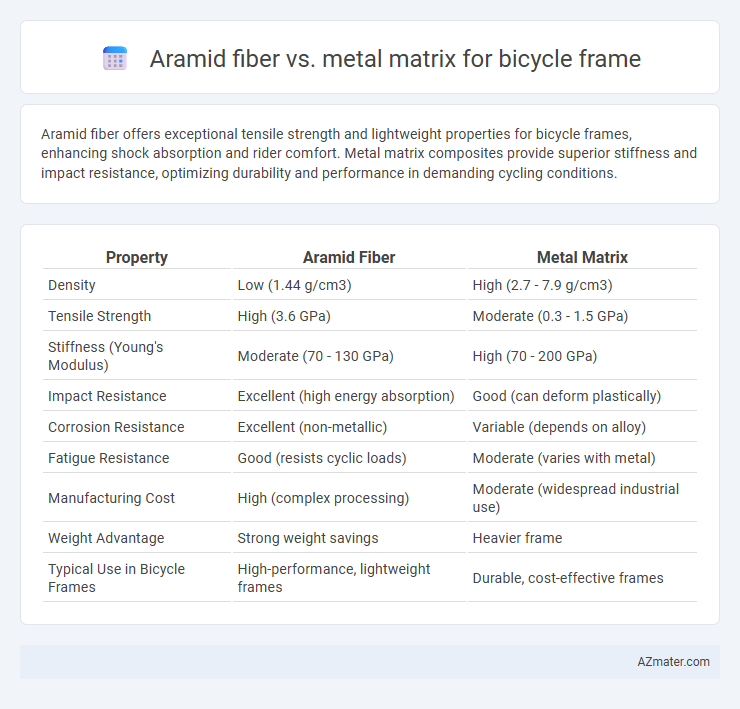Aramid fiber offers exceptional tensile strength and lightweight properties for bicycle frames, enhancing shock absorption and rider comfort. Metal matrix composites provide superior stiffness and impact resistance, optimizing durability and performance in demanding cycling conditions.
Table of Comparison
| Property | Aramid Fiber | Metal Matrix |
|---|---|---|
| Density | Low (1.44 g/cm3) | High (2.7 - 7.9 g/cm3) |
| Tensile Strength | High (3.6 GPa) | Moderate (0.3 - 1.5 GPa) |
| Stiffness (Young's Modulus) | Moderate (70 - 130 GPa) | High (70 - 200 GPa) |
| Impact Resistance | Excellent (high energy absorption) | Good (can deform plastically) |
| Corrosion Resistance | Excellent (non-metallic) | Variable (depends on alloy) |
| Fatigue Resistance | Good (resists cyclic loads) | Moderate (varies with metal) |
| Manufacturing Cost | High (complex processing) | Moderate (widespread industrial use) |
| Weight Advantage | Strong weight savings | Heavier frame |
| Typical Use in Bicycle Frames | High-performance, lightweight frames | Durable, cost-effective frames |
Introduction: Aramid Fiber vs Metal Matrix in Bicycle Frames
Aramid fiber composites offer high strength-to-weight ratios and excellent impact resistance, making them ideal for lightweight and durable bicycle frames. Metal matrix composites provide superior stiffness and thermal stability, enhancing frame rigidity and performance under dynamic loads. Comparing aramid fiber to metal matrix materials reveals a balance between flexibility and strength crucial for optimizing bicycle frame design.
Material Properties Overview
Aramid fiber composites offer exceptional tensile strength, high impact resistance, and lightweight characteristics compared to metal matrix materials, making them ideal for reducing overall bicycle frame weight and enhancing durability. Metal matrix composites provide superior stiffness, thermal stability, and excellent fatigue resistance, enabling greater rigidity and performance under repetitive stress conditions. The choice between aramid fiber and metal matrix depends on prioritizing lightweight flexibility versus structural stiffness and thermal endurance for optimized bicycle frame performance.
Strength-to-Weight Ratio Comparison
Aramid fiber composites offer a superior strength-to-weight ratio compared to metal matrix materials, making them ideal for lightweight bicycle frames that require high tensile strength and impact resistance. While metal matrix composites provide excellent stiffness and thermal stability, their higher density results in heavier frames, reducing overall efficiency for cyclists. The lightweight nature of aramid fibers contributes to enhanced maneuverability and reduced rider fatigue, crucial for performance-oriented bicycles.
Durability and Fatigue Resistance
Aramid fiber composites exhibit superior fatigue resistance compared to metal matrix materials, maintaining structural integrity under cyclic loading due to their high tensile strength and energy absorption capabilities. Metal matrix frames, while offering excellent stiffness and impact resistance, are more prone to micro-cracking and fatigue degradation over extended use. The enhanced durability of aramid fiber in resisting crack propagation makes it a preferred choice for high-performance bicycle frames requiring long-term reliability.
Vibration Damping and Ride Comfort
Aramid fiber composites offer superior vibration damping properties compared to metal matrix materials, significantly reducing road vibrations transmitted to the rider and enhancing overall comfort. Metal matrix frames, while stronger and stiffer, tend to transmit more vibrations, potentially leading to increased rider fatigue on longer rides. The combination of aramid fiber's energy absorption and inherent flexibility makes it an optimal choice for cyclists seeking smoother ride quality and improved shock absorption.
Corrosion and Environmental Resistance
Aramid fiber exhibits superior corrosion resistance compared to metal matrix materials, as it does not oxidize or degrade when exposed to moisture, salt, or chemicals. Metal matrix composites often suffer from corrosion, especially aluminum-based ones, requiring protective coatings to enhance durability. Environmental resistance of aramid fibers contributes to longer frame lifespan and reduced maintenance in harsh weather conditions.
Manufacturing Processes and Design Flexibility
Aramid fiber composites offer significant design flexibility due to their ability to be molded into complex shapes through processes like filament winding and resin transfer molding, providing high strength-to-weight ratios ideal for custom bicycle frames. Metal matrix composites (MMCs), typically manufactured via powder metallurgy or casting techniques, present challenges in intricate shaping but provide superior stiffness and thermal resistance, making them suitable for high-performance, durable frames. The choice of manufacturing process directly impacts frame properties, with aramid fibers enabling lightweight, aerodynamic designs, while MMCs favor robustness and impact resistance in frame construction.
Cost and Market Availability
Aramid fiber, known for its lightweight and high tensile strength, generally has a higher cost due to complex manufacturing processes and limited mass production compared to metal matrix composites used in bicycle frames. Metal matrix materials, often aluminum or magnesium-based, offer greater market availability and more cost-effective options for consumers seeking durability and affordability. The choice between aramid fiber and metal matrix frames often hinges on balancing budget constraints with performance priorities in competitive cycling markets.
Performance in Real-World Cycling Conditions
Aramid fiber bicycle frames offer exceptional impact resistance and vibration damping, enhancing rider comfort and control on rough terrains. Metal matrix frames provide superior stiffness and durability, delivering efficient power transfer and long-term structural integrity under high-stress riding conditions. Performance in real-world cycling tests shows aramid fiber frames excel in absorbing shocks, while metal matrix frames maintain precise handling and responsiveness during intense pedaling and cornering.
Conclusion: Choosing the Right Material for Your Bicycle Frame
Aramid fiber offers exceptional strength-to-weight ratio and excellent vibration damping, making it ideal for lightweight, high-performance bicycle frames. Metal matrix composites provide superior stiffness and impact resistance but tend to be heavier and less vibration-absorbent. Selecting the right material depends on prioritizing either weight reduction and ride comfort with aramid fiber or enhanced durability and stiffness with metal matrix composites.

Infographic: Aramid fiber vs Metal matrix for Bicycle frame
 azmater.com
azmater.com